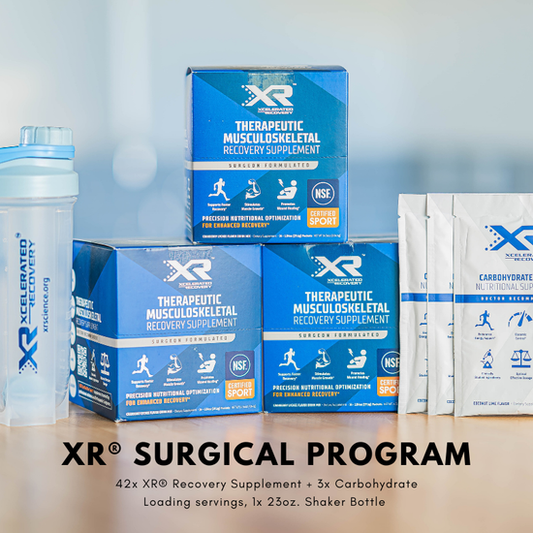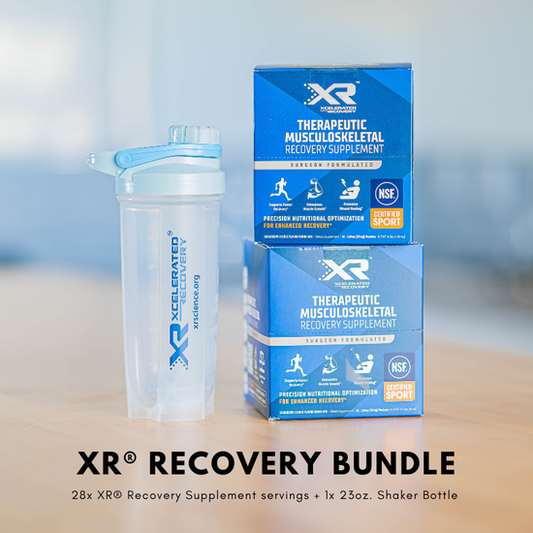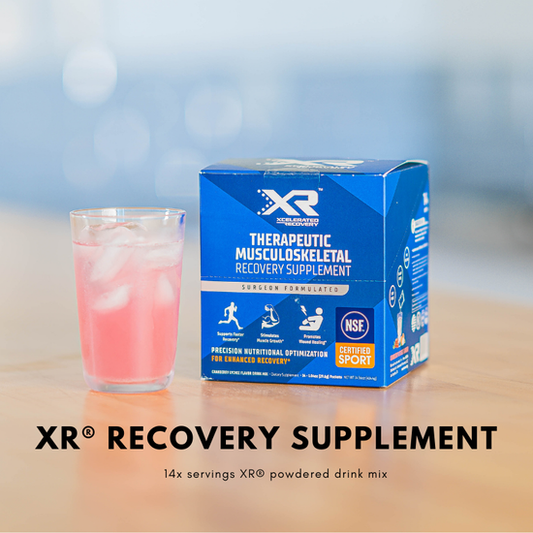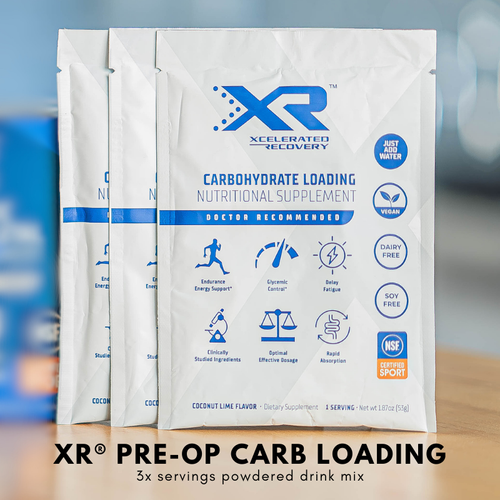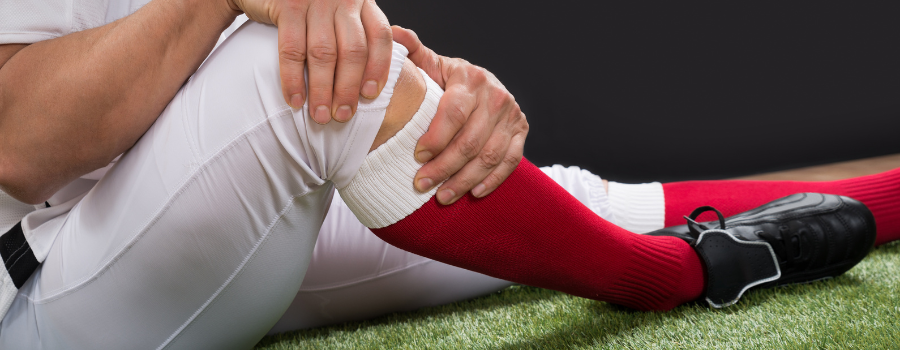
Succeeding with ACL Surgery: A Guide to Optimizing Your Outcome
Share
Authors: Dr. Jazayeri, Dr. Kaplan & Adam C. Cady MHS
ACL (anterior cruciate ligament) injuries are extremely common, especially among athletes who participate in sports that involve cutting, pivoting, and jumping. Approximately 200,000 ACL injuries occur in the United States each year1.
Muscle atrophy (loss) is a common complication after an ACL injury, especially if the injury requires surgery and a prolonged period of immobility. It is not uncommon to see a 20-30% loss of muscle mass in the affected limb within the first few weeks after an ACL injury alone.
Muscle atrophy is further compounded by the stress of ACL reconstruction (ACLR) surgery. Though surgical reconstruction of the ACL is effective in restoration of anatomy and stability of the knee, significant deficits in quadriceps muscle volume and strength persist long into the recovery.
Patients can experience up to a 25% loss of quadriceps muscle volume, with persistence up to 6 months post ACLR2. In relation, quadriceps strength can decrease as much as 30% following ACL surgery4. Some studies have shown quadriceps strength deficits and imbalances for up to 2-4 years post ACLR 3,4.
This presents a major challenge for patients who wish to return to sports (RTS) safely, as quadriceps muscle weakness and imbalances can increase the risk of recurrent ACL tears 12,13. The peak period for secondary injuries is within 2 years post-surgery and young, active patients are at a high risk of another ACL injury, with an increased likelihood of 15 times in the first 12 months14 and 5 times in the first 24 months15 after returning to sports. Over 30% of patients who suffered a second ACL injury did so in fewer than 20 athlete-exposures, highlighting the need for improved rehabilitation plans to prevent complications during this high-risk period.
To minimize muscle loss during recovery, it is essential for patients to work closely with their healthcare team to develop an individualized recovery plan that focuses on strategies to mitigate muscle atrophy in the perioperative period. Prehabilitation (prehab), is a proactive approach to addressing deficits in strength, stability, and range of motion in preparation for surgery. Prehab has been shown to affect outcomes related to self reported knee function, functional return to sport testing, balance, and strength in individuals post ACLR9,10.
Nutrition and nutritional supplementation are key components of the individualized recovery plan, as both have been shown to mitigate muscle atrophy and strength deficits following ACLR.
The injured athlete requires additional nutritional support to be prepared to handle the surgical stress cascade, as Hirsch et al. (2021) have described as a “cascade of inflammatory, immune, and metabolic responses that result in a hypermetabolic-catabolic state”.
This state increases the demand for amino acids, leading the body to break down skeletal muscle, which serves as a reservoir for amino acids, in order to meet energy demands and promote wound healing. However, this muscle breakdown leads to muscle atrophy, which is further exacerbated by the limited activity and immobility during the healing process. This compounds the underlying muscle loss and presents a significant barrier to recovery.
Protein is an essential nutrient for muscle recovery and growth. Studies have shown that consuming personalized amounts of protein can help mitigate muscle loss and strength deficits following ACL reconstruction, if provided appropriately in the early recovery phase7.
Amino acids also play a critical role in muscle recovery and growth. Studies have shown that supplementing with essential amino acids, particularly leucine, can help stimulate muscle protein synthesis and promote muscle recovery6. Specific to recovery in ACL reconstruction research, leucine supplementation correlates with increased muscle volume and strength11. Nutritional supplementation, including specific combinations of β-hydroxy-β-methyl butyrate (HMB), L-arginine, L-glutamine, and essential amino acids have been effectively used to improve postoperative recovery, prevent muscle wasting, reduce inflammation, and accelerate functional recovery after multiple orthopaedic procedures including joint replacement and trauma surgery. Such advances in nutritional supplementation can be implemented in recovery of phase of ACL injuries to enhance outcomes.
In summary, ACL reconstruction is a common procedure for treating ACL injuries and minimizing muscle loss during recovery is crucial for patients' ability to safely return to sports and lowering complications. Prehabilitation, or prehab therapy, is an effective strategy that involves engaging in physical and nutritional therapy prior to surgery and has become the standard for elective orthopedic surgeries. It is essential for patients to work closely with their healthcare team to develop an individualized rehabilitation plan that focuses on maintaining and improving muscle strength and consider prehabilitation and nutritional supplementation as important strategies to optimize recovery outcomes.
References:
- AAOSs updates clinical practice guideline for management of anterior cruciate ligament injuries.
- "Muscle Atrophy After Anterior Cruciate Ligament Reconstruction: A Systematic Review and Meta-analysis." Journal of Orthopaedic Research, vol. 37, no. 2, 2019, pp. 437–447., doi:10.1002/jor.24142.
- "Quadriceps muscle weakness: a predictor of slower functional recovery after anterior cruciate ligament reconstruction." Journal of Orthopaedic & Sports Physical Therapy, vol. 42, no. 3, 2012, pp. 249–256., doi:10.2519/jospt.2012.3609.
- "Muscle Atrophy and Strength Deficits After Anterior Cruciate Ligament Reconstruction: A Systematic Review." Journal of Athletic Training, vol. 53, no. 2, 2018, pp. S1–S15., doi:10.4085/1062-6050-53-2S-S1.
- Thomas AC, Villwock M, Wojtys EM, Palmieri-Smith RM. Lower extremity muscle strength after anterior cruciate ligament injury and reconstruction. J Athl Train. 2013;48(5):610-620. doi:10.4085/1062-6050-48.3.23
- Matsui Y, Takayanagi S, Ohira T, et al. Effect of a leucine-enriched essential amino acids mixture on muscle recovery. J Phys Ther Sci. 2019;31(1):95-101. doi:10.1589/jpts.31.95
- Holm L, Esmarck B, Mizuno M, et al. The effect of protein and carbohydrate supplementation on strength training outcome of rehabilitation in ACL patients. J Orthop Res. 2006;24(11):2114-2123. doi:10.1002/jor.20147
- Do-Kyung Kim, Geon-Park, Jae-Ho Yu. The Effect of Protein Supplementation Improve Quadriceps Muscle Strength with ACL Reconstruction. Research J. Pharm. and Tech. 2017; 10(9): 2871-2874. doi: 10.5958/0974-360X.2017.00506.6
- Carter, H.M., Littlewood, C., Webster, K.E. et al. The effectiveness of preoperative rehabilitation programmes on postoperative outcomes following anterior cruciate ligament (ACL) reconstruction: a systematic review. BMC Musculoskelet Disord 21, 647 (2020). https://doi.org/10.1186/s12891-020-03676-6
- Giesche F, Niederer D, Banzer W, Vogt L (2020) Evidence for the effects of prehabilitation before ACL-reconstruction on return to sport-related and self-reported knee function: A systematic review. PLOS ONE 15(10): e0240192. https://doi.org/10.1371/journal.pone.0240192
- Laboute E, France J, Trouve P, Puig PL, Boireau M, Blanchard A. Rehabilitation and leucine supplementation as possible contributors to an athlete’s muscle strength in the rehabilitation phase following anterior cruciate ligament surgery. Annals of Physical and Rehabilitation Medicine. 2013;56(2):102-112.
- Mark V. Paterno, PhD, ATC, PT, SCSIncidence and Predictors of Second Anterior Cruciate Ligament Injury After Primary Reconstruction and Return to SportJournal of Athletic Training 2015;50(10):1097–1099 doi: 10.4085/1062-6050-50.10.07
- R Gupta 1, A Singhal 1, A Malhotra 1, A Soni 1, G D Masih 1, M Raghav 1Malays Orthop J . Predictors for Anterior Cruciate Ligament (ACL) Re-injury after Successful Primary ACL Reconstruction (ACLR) 2020 Nov;14(3):50-56. doi: 10.5704/MOJ.2011.009.
- Paterno MV, Rauh MJ, Schmitt LC, Ford KR, Hewett TE. Incidence of contralateral and ipsilateral anterior cruciate ligament (ACL) injury after primary ACL reconstruction and return to sport. Clin J Sport Med. 2012;22(2):116–121. [PMC free article] [PubMed] [Google Scholar]
- Paterno MV, Rauh MJ, Schmitt LC, Ford KR, Hewett TE. Incidence of second ACL injuries 2 years after primary ACL reconstruction and return to sport. Am J Sports Med. 2014;42(7):1567–1573. [PMC free article] [PubMed] [Google Scholar]





